Jet Set Radio Future Preview
We have a playable version of this much-anticipated Xbox game.
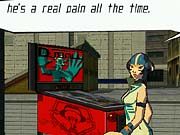
Many feel that the original Jet Set Radio--released in the US as Jet Grind Radio--didn't get the attention it deserved. The innovative, engaging game didn't make it on the casual gamer's radar, though those who actually played it became the staunchest of fans. Sadly, there weren't enough fans--the game didn't sell especially well. Considering this, it's pretty neat that Sega is having Smilebit develop a second installment and is also giving the game a pretty large promotional push--the type of attention, in truth, that the first probably should have received.
Jet Set Radio Future takes place several years after the original and is set in a somewhat futuristic Tokyo. The setting is familiar yet slightly alien; buzzing light sculptures stand alongside common thoroughfares, for instance, lending the mundane environments a touch of futurist pizzazz. For those unfamiliar with Jet Set Radio's world and premise, it's really quite novel. A bunch of street gangs are vying for territory in Tokyo, and their tool for settling disputes is a spray can. To mark their dominance, these youths mark up the walls of rivals' territories and often even the rivals themselves. And they do this while riding inline skates. As you've imagined, this translates pretty well to gameplay; the original Jet Set Radio was built on an almost platformerlike philosophy, which had you linking huge grinds to huger jumps to access the spots you needed to paint. Add to this the presence of the law, and, in many cases, rival gangs themselves, and things could get pretty frenetic.
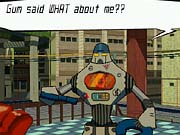
In this sequel, as well as in the original, players will take control of the GGs, a scrappy and stylish young gang. The GGs are again aided by Professor K--who has aged a few years--a figure in Tokyo's underground radio, and he seems to be keen on the movements of rival gangs and on the oppressive arms of the law. Just as in the first game, the lawmen who seemingly simply want to "clean up the streets" are up to something devious, the nature of which isn't evident till later. You can bet to hear the name Rokkaku more than a few times. In place of the sleazy and violent Inspector Onishima is a thinner, sleeker man, who is armed with a Luger and lurks with a faceless death squad. Eventually, however, you learn that he shares Onishima's fetish for weird iconography--images you'll no doubt have to beautify with your spray count.
Jet Set Radio Future doesn't do too much to this formula. The action is essentially the same, though the game has seen a few refinements and additions. Most of them pertain to its design--some key systems have been changed, and others have been removed entirely. The levels also feel a bit different. JSRF's aesthetic improvements, though, are most immediately noticeable and are likely to make fans of the original quite happy.
Looks
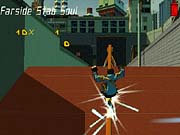
The original Jet Set was a very cool-looking game. Smilebit, the Sega dev team that created the game, essentially pioneered the cel-shading technique with Jet Set Radio, and its influence throughout the industry was immediately undeniable. The style is inspired and inimitable; manga art and urban culture aesthetics were blended with the straight and narrow color schemes of commercial package design, and the result was very cool. The game looked like a very sharp moving comic book, and reaching every new environment was a thrill as a result. Logically, Jet Set Radio Future doesn't mess with this too much, but, rather, brings to it the niceties that only a post-Dreamcast platform can provide.
The most evident visual touch is the game's frame rate. When it isn't slowing down (which seems to happen more frequently than we'd like at this point), the game runs at a silky 60 frames per second. For visual context, imagine the first one running twice as fast. The effect is truly awesome, and we frequently played through the "nonproblem" areas to experience it just for fun. Even when the game slows down, no frames are lost in the process, so it still looks supersmooth, albeit in slow motion. This doesn't justify it, however--the effect is definitely jarring, and it's our sincerest hope that Smilebit will optimize the slowdown into nonexistence.
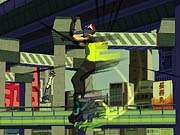
Other subtleties have been added, which, when taken as a whole, add a whole lot to the visual package. When you're speeding along, motion lines will emphasize your movement. Some are black lines that simply trail you as you travel, and others are angular blurs that protrude from your body. The effect is pretty cool, and although it's subtle, it does much to further the game's "hypermanga" feel. A cool effect has been added to the game's boost mechanic as well. When it's executed, you'll likely notice that you've done something spectacular. The effect is explosive and rough and is better left for pictures--rather than words--to describe. Images are saturated, and everything is blurred or else cut up into particles of light. The effect is pretty amazing, and it doesn't lose its luster after a few runs.
Many fans of Jet Set Radio will also remember its tasteful soundtrack. Composed by Hideki Naganuma, the sonic urban mosaic fit the theme exceptionally, and its individual tracks mixed into one another with maddening fluidity. It almost felt as if it were one long mix as opposed to a set of discrete tracks. In any event, Naganuma reprises his contribution in JSRF and is accompanied by a host of other artists, whose work Sega has licensed. The list is pretty large, and it includes the Scottish band bis, Cibbo Matto from New York, London's Richard Jaques, as well as many others. The same blending of tracks happens here, but given the diversity of the lineup, the fluidity is sadly gone. Segues are now accompanied by radio-dial static, which, by all accounts, isn't such a big deal. You unlock new songs for the soundtrack by finding golden tapes that are scattered throughout the game's environments, usually in remote areas. Finding a new song is pretty satisfying, which, when coupled by the graffiti souls--which unlock new pieces for your characters to paint--serves to further the game's incorporation of platform conventions. They'll keep you coming back to previous levels in any event.
Charm
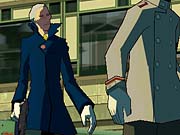
It's easy to focus on the game's aesthetic production, but, in truth, it's the game's design that has been most radically altered. Again, none of the changes are all too major, but, when taken as a whole, they have a pretty strong effect. The action in the game's individual levels were affected the most. First, there is no constant cop presence in any of the stages. You're free to explore the environments, collect hidden items, and paint, for the most part, at your leisure. Most stages also do not have a time meter. The ones that do usually have it for a reason-- for instance, if you're racing against a rival gang to accomplish some end. The cops are dealt with in an altogether different manner. After completing certain stages in certain areas, the law will catch up with you. The sequence that ensues takes place in a tight, closed-up environment, usually lined by electric fences, and your goal is to take out each trooper in the assaulting squad. You do this, of course, by painting their bodies, but first, you've got to knock them down. The original Jet Set didn't ever get as offense-heavy as this, and it's indeed sort of satisfying to strike back at the law. Basically, depending on what type of trooper you're facing, you either have to skate or dash into him to floor him. Once down, he'll remain so for a few seconds, which gives you a chance to spray him. Do this enough times, and you'll take him out. If you're not careful, though, you'll get mobbed by them, so you have to be sure to engage them when they're broken up into smaller groups. Also, these squads will often be accompanied by their Luger-strapped leader, who doesn't hesitate to wield mortal force. You deal with him the same way--rush, and spray, though, of course, you have to do it a few more times than with his cronies.
The layout of the world has also changed quite a bit--or, more specifically, the way you access individual areas. Rather than simply selecting areas from a map, you actually have to travel through the world in JSRF. You have constant access to both an area map as well as a world map, which makes it easy to get to and fro. The world's epicenter is your garage, where all of the members of the GGs you've unlocked reside. Here, you can also access the graffiti editor, listen to the game's soundtrack, and access saved data, as well as interact with your robotic friend, who serves as the tutorial dispenser. In all, JSRF's version of near-future Tokyo is brought to life by this new layout; you ultimately have more contact with the world's discrete districts, which is why Smilebit has placed hidden objects all throughout them. And it's easily one of the coolest video gameworlds yet conceived, so you're in for a treat regardless.
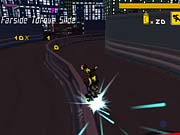
Some alterations have been made to the game's mechanics--some radical, some subtle. First, as mentioned in earlier previews, you no longer have to input directional commands when you paint; you simply whiz by the spot and hit the R trigger to paint a section. Do this enough times, and your piece will appear like magic. It's kind of sad to see the mechanics go, but it is something of a mixed blessing; not having to stop to paint lends the game a generally faster pace, which goes well with the overall faster pace. Dashing too, aside from its visual breakout, has been redone. Your dash is much faster this time around, though it costs you a steep 10 cans to execute. Cans are seldom in short supply, though, so you don't have to practice a huge amount of restraint. Something you'll also notice is that you now can grind vertically on surfaces--on light poles or pipes, for instance. You're able to link grinds more effectively as a result, making your grind lines significantly larger. Finally, a small tweak has been added to the trick system--you can now skate backward by hitting the Y button, and doing so many times in quick succession while grinding counts as doing tricks. If nothing else, it gives you something to do when on long grinds.
Jet Set Radio Future is easily one of the coolest Xbox games in development. The original was an unsung classic, and it would be a shame if this sequel didn't get the attention it deserved. It would be just as sad, however, if the slowdown problems that bring it down at this point aren't remedied by the time the game ships. Here's to hoping they're good and gone by then. We'll have more for you once we get an updated build. Till then, enjoy a whole mess of media.
Got a news tip or want to contact us directly? Email news@gamespot.com
Join the conversation